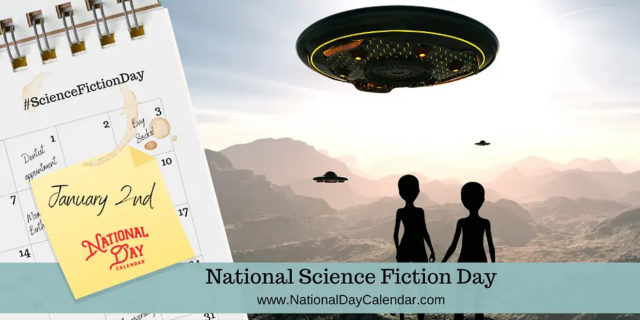
National Science Fiction Day promotes the celebration of science fiction as a genre, its creators, history, and various media, too. On January 2nd annually, millions of science fiction fans across the United States read and watch their favorites in science fiction.
The date of the celebration commemorates the birth of famed science fiction writer Isaac Asimov. An American author and Boston University professor of biochemistry, Isaac Asimov was born Isaak Yudovich Ozimov on January 2, 1920. He is best known for his works of science fiction and his popular science books. Isaac Asimov, whose works are followed by many, died on April 6, 1992.
- Considered a master of hard science fiction, Asimov, along with Robert A. Heinlein and Arthur C. Clarke, was considered one of the “Big Three” science-fiction writers during his lifetime. Many regard the Foundation Series as Asimov’s most outstanding piece. His other major series are the Galactic Empire Series and the Robot Series.
- Some of the successful television shows recognized by science fiction fans include Star Trek-The Next Generation, The X-Files, Battlestar Galactica, Doctor Who, and The Twilight Zone.
- Asimov coined the term “robotics” in his 1941 story “Liar!”. Asimov also coined the term “spome” in a paper entitled, “There’s No Place Like Spome” in Atmosphere in Space Cabins and Closed Environments, and then the term “psychohistory” in his foundation stories to name a fictional branch of science which combines history, sociology, and mathematical statistics to make general predictions about the future behavior of very large groups of people.
- Arguably the inspiration for much science fiction traces back to classical mythology. Think of it—Earthlings abducted by beings from the sky, humans morphing into strange creatures, and events that defy the laws of nature.
- In 1926 writer Hugo Gernsback founded Amazing Stories, the first true science-fiction magazine.
- Writers for the early pulp magazines would often write under multiple pseudonyms so they could have more than one article per issue. Ray Bradbury—taking this practice to another level—used six different pen names. During the 1960s, James Tiptree Jr. penned sci-fi classics like Houston, Houston, Do You Read? but was so secretive that people suspected he was a covert government operative. At age 61, Tiptree was outed—not as a spy but as outspoken feminist Alice B. Sheldon.
- Irony alert: Ray Bradbury, one of the world’s most influential SF writers, studiously avoids computers and ATMs and claims he has never driven a car.
- Not to be outdone, sci-fi legend Isaac Asimov wrote about interstellar spaceflight but refused to board an airplane.
- Neal Stephenson’s acclaimed 1992 novel Snow Crash has inspired two major online creations: Second Life (derived from Stephenson’s virtual Metaverse) and Google Earth (from the panoptic Earth application).
- Sci-fi author Gene Wolfe helped develop the machine that cooks Pringles, while Robert Heinlein conceived the first modern water bed.
- Fans of Star Trek will remember the replicator. Replicators were devices capable of instantly materializing almost any object with a simple command. While 3D printers can’t quite pull objects out of thin air, they do act similarly to replicators, reproducing jewelry, food, and even body parts.
- In his 1984 novel Neuromancer, novelist William Gibson predicted hacking, virtual reality, the world wide web, and cyberspace a decade before the internet took the form we know today.
- Jules Verne’s works spawned a number of inventions, the most famous of which is the electric submarine.
- In his 1888 novel Looking Backward, Edward Bellamy introduced the concept of universal credit: The citizens of his future utopia carried a card with them that allowed them to spend credit from a central bank, without a need for paper money.
- A famous Star Trek gadget was the communicator, which looks similar to the cell-phones of today. Martin Cooper, who oversaw the invention of the first mobile phone in the 70s, directly credited Star Trek for inspiring his vision.
- Another Star Trek invention to cross into reality is the PADD, a device first seen in Star Trek TNG in the late 80s. The PADD, or Personal Access Display Device, bore a strong resemblance to today’s iPads, and utilized a similar smooth, flat, touch-screen interface.
- AT&T first demonstrated consumer video conferencing at the 1964 World’s Fair, but the first discussion of the idea appeared in Hugo Gernsback’s Ralph 124c 41+. Published in Modern Electronics magazine in 1911, the story included a device called the “telephot” that allowed people to have eye contact while speaking across long distances.
- Children growing up in the early 1900s would have been familiar with the Tom Swift series of books. In the books, the main character Tom Swift made use of a stun gun. When NASA physicist Jack Clover invented the taser, he gave it that name as a nod to the series. TASER actually stands for “Thomas A. Swift’s Electric Rifle.”
- A 1999 Disney channel movie called Smart House featured a robot called PAT (Personal Applied Technology) that can make phone calls, control the temperature, start music, and even adapt dinner menus. The Amazon Echo and Google Home are smart digital assistants that can assist with shopping, control the other smart devices in your home, stream music, and manage your calendar.
- The term ‘genetic engineering’ was invented by science-fiction author Jack Williamson in his 1951 novel, Dragon’s Island.
- The first known use of the word ‘prequel’ was in 1958 in reference to a novel by science-fiction author James Blish.
- The word ‘spaceship’ dates back to 1880.
- The phrase ‘parallel universe’ was first used in H. G. Wells’ 1923 novel Men like Gods.
- The word ‘robot’ was invented by the brother of a Czech playwright in 1920.
- Jules Verne’s 1863 book Paris in the Twentieth Century, set in Paris in 1960, correctly predicted cars, fax machines, and the internet.
- In 1974, Arthur C. Clarke predicted the internet of the year 2001.
- In the first chapter of his 1948 novel Space Cadet, Robert Heinlein predicted mobile phone technology.
- John Brunner’s 1969 novel Stand on Zanzibar uncannily predicted many features of the 21st-century world, including overpopulation, Viagra, same-sex marriage, and even President Obama.
- Edward Bellamy’s 1888 novel Looking Backward: 2000-1887 predicted credit cards, garden cities, and electronic broadcasting.
Sources:












